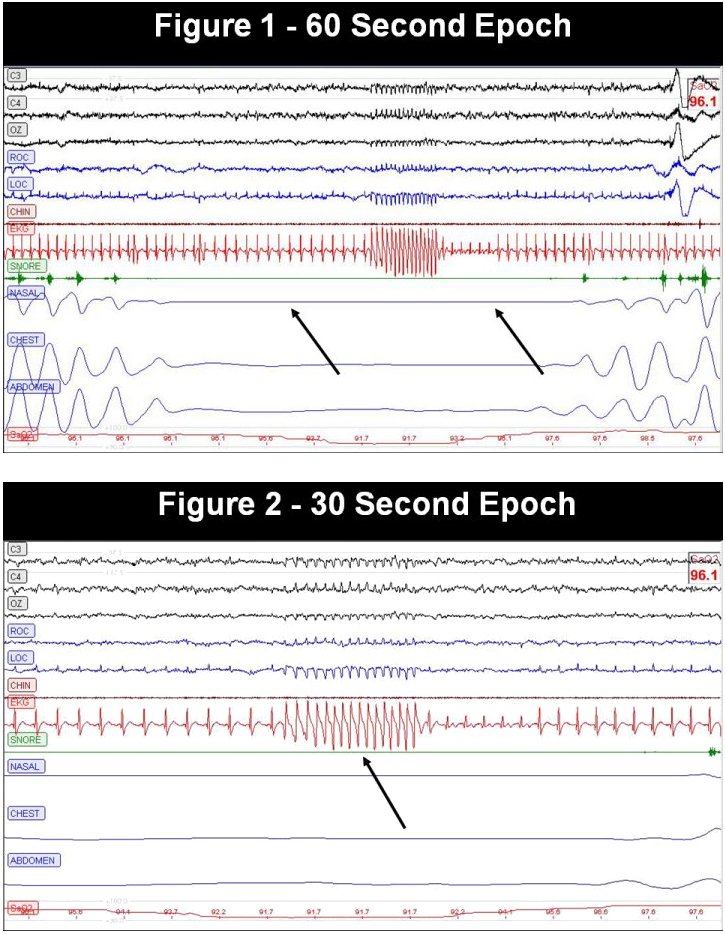Contributed by Richard J. Schwab, MD, University of Pennsylvania, Philadelphia, PA
History:
- 76 years old gentleman
- Complains of snoring and sleep fragmentation
- History of congestive heart failure, hypertension, hyperlipidemia, myocardial infarction and atrial septal defect
- Epworth sleepiness scale of 5; not short of breath
Physical exam:
- Height 5’10”, weight 180 lbs - BMI of 25.8 kg/m²
- Modified Mallampati class 3 airway with mild macroglossia
- Lower extremity edema (1+)
Remainder of examination normal
Question 1: In Figure 1 the arrows illustrate which type of respiratory event?
Question 2: In Figure 2 the arrow illustrates which type of cardiac arrhythmia?
Question #1: Answer: Central apnea
Discussion: The American Association of Sleep Medicine Manual for the Scoring of Sleep and Associated Events (1) provides standardized definitions for the various respiratory events. This fragment demonstrates a central apnea. An apnea is obstructive if there is inspiratory effort, and central if the inspiratory effort is absent. In this example there is no respiratory effort so it is a central event. There is a high prevalence of central sleep apnea in patients with severe but asymptomatic left ventricular dysfunction (2). An apnea is mixed when there is absent inspiratory effort in the initial portion of the event, followed by a resumption of inspiratory effort in the second portion of the event.
Question #2: Answer: Non-sustained ventricular tachycardia
This fragment demonstrates nonsustained ventricular tachycardia (a wide complex tachycardia). Atrial fibrillation and atrial flutter would be narrow complex unless they were associated with aberrant conduction. There is no evidence for bradycardia or heart block.
Patients with central sleep apnea and heart failure have been shown to have a high prevalence of nonsustained ventricular tachycardia (2). In Figure 1 there are isolated ventricular premature contractions on either side of the nonsustained ventricular tachycardia.
Sleep apnea is commonly associated with nocturnal arrhythmias. A majority of the arrhythmias are benign (bradycardia/tachycardia {bradycardia during the apnea and tachycardia during the arousal}, atrial and ventricular ectopy), especially if the cardiac substrate is normal. However, all types of cardiac arrhythmias (heart block, nonsustained ventricular tachycardia, and atrial fibrillation) have been reported. Data from the Sleep Heart Health Study have shown that patients with OSA had a higher prevalence of non-sustained ventricular tachycardia, complex ventricular ectopy, and atrial fibrillation compared to controls without sleep disordered breathing (3). A high prevalence of atrial fibrillation has been reported in patients with sleep apnea (4). CPAP has been shown to reduce ventricular ectopy and other ventricular arrhythmias in heart failure patients with sleep apnea (5, 6).
References
-
- Iber C, Ancoli-Israel S, Chesson AL, Quan SF. The AASM manual for the scoring of sleep and associated events. American Academy of Sleep Medicine 2007.
- Lanfranchi PA, Somers VK, Braghiroli A, Corra U, Eleuteri E, Giannuzzi P. Central sleep apnea in left ventricular dysfunction: prevalence and implications for arrhythmic risk. Circulation 2003; 107:727-32.
- Mehra R, Benjamin EJ, Shahar E, Gottlieb DJ, Nawabit R, Kirchner HL, Sahadevan J, Redline S. Association of nocturnal arrhythmias with sleep-disordered breathing: The Sleep Heart Health Study. Am J Respir Crit Care Med 2006; 173:910-6.
- Gami AS, Pressman G, Caples SM, et al.: Association of atrial fibrillation and obstructive sleep apnea. Circulation 2004; 110:364-367.
- Ryan CM, Usui K, Floras JS, Bradley TD. Effect of continuous positive airway pressure on ventricular ectopy in heart failure patients with obstructive sleep apnea. Thorax 2005; 60;781-785.
- Javaheri S. Effects of continuous positive airway pressure on sleep apnea and ventricular irritability in patients with heart failure. Circulation 2000; 101; 392-397.




